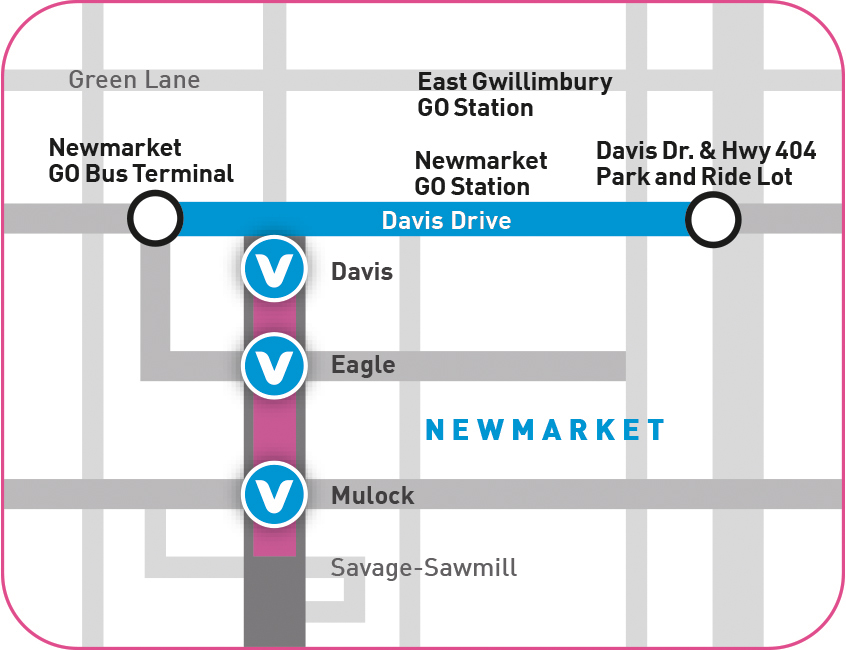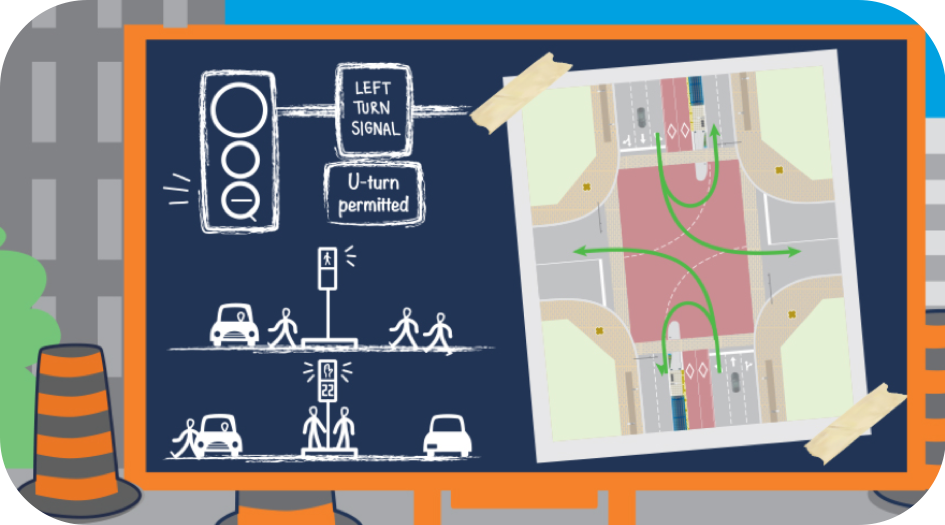Questions
What is opening for service?
How are traffic patterns changing?
Will pedestrians be able to easily cross the street?
How do people get to the station in the centre of the road?
What happens in the event of an emergency on a station platform?
How will drivers know which lanes to stay out of?
How will the rapidways be maintained?
Routes
What transit services and routes will use the new rapidway?
If I take the Davis Drive Viva Yellow to Yonge Street, can I transfer to a Yonge Viva Blue bus?
How frequent will service be?
How does fare pricing work when transferring between Viva and the TTC?
Can I pay my YRT fare without PRESTO? Can I use cash to buy a ticket?
How do I use PRESTO for my fare?
Are there plans for fare integration between Viva and other transit services?
Why don’t local YRT routes use the rapidway?
How will Viva rapidway service differ from my curbside Viva service?
Cycling
Where can pedestrians and cyclists travel along this section?
Where do cyclists go once the raised bike lanes end at either north of Davis or south of Savage/ Sawmill Valley?
Contacts
Answers

What is opening for service?
A 2.4-kilometre segment of Viva bus rapid transit [rapidway] along Yonge Street in Newmarket, will be open for service, from Savage Road / Sawmill Valley Drive to Davis Drive. There will be three new centre stations located at Mulock Drive, Eagle Street and Davis Drive.
How are traffic patterns changing?
Rapidways change how motorists access driveways and streets between intersections. The rapidway provides safer left turns for drivers, with dedicated left-turn signals at intersections and the ability to make protected U-turns.
The elimination of mid-block left turns will help in avoiding common side-impact accidents in the median of the roadway during times of heavy traffic. This measure also helps to improve the flow of traffic.

Will pedestrians be able to easily cross the street?
At signalized intersections with viva stations, pedestrians may cross in two stages if unable to get to the other side during the first signal.
To help guide you safely across, new pedestrian signals and a pedestrian countdown have been installed. The countdown will let pedestrians know how many seconds they have left to safely cross the street.
There is also a waiting area in the middle of the crosswalk, where pedestrians can push the “walk” button and wait for the next light before crossing the second half of the street, if needed.
How do people get to the station in the centre of the road?
People can get to the station by crossing at the signalized intersection and turning onto the platform ramp at the centre of the crosswalk. To return to the sidewalk from the station, a pedestrian light with push-button activation is located at the centre of the crosswalk at the platform ramp.
What happens in the event of an emergency on a station platform?
You can push the emergency call button for [24/7] assistance and your call will be answered by a York Region Enforcement Dispatcher which allows for two-way communication. Surveillance cameras will pan to the emergency call button area and blue pulsing lights on the platform will be activated to attract the attention of responders.
How will drivers know which lanes to stay out of?
We have designed a number of features to ensure the rapidway is easy to see, including paving it with red asphalt, “bus only” pavement markings and dotted lines through intersections to help guide drivers in their lane.
How will the rapidways be maintained?
Once the rapidway goes into service, York Region maintains the roadway and the raised bike lanes, YRT maintains the stations and the Town of Newmarket maintains the sidewalks.
Routes
What transit services and routes will use the new rapidway?
Viva Blue will use the rapidway on Yonge Street, with a new Viva stop on Yonge at Davis Drive.
When the rapidway opens, Viva will no longer access the Newmarket GO Bus Terminal from Eagle Street, but rather, will travel along Yonge, turning west at Davis Drive, and continuing to the Newmarket GO Bus Terminal.
If I take the Davis Drive Viva Yellow to Yonge Street, can I transfer to a Yonge Viva Blue bus?
In order to transfer to the Yonge Street Viva Blue service from the Davis Drive Yellow service, customers would make that connection at the Newmarket Go Bus Terminal at Davis and Eagle Street.
How frequent will service be?
Frequency and the rapidway are what will put the rapid into rapid transit. Viva is already known for being frequent and when the Yonge Street rapidway opens, schedules will be adjusted to ensure appropriate spacing between arrivals.
Viva and YRT routes are evaluated by YRT’s Service Planning branch on a regular basis, and service changes are made to routes and schedules as needed.
How does fare pricing work when transferring between Viva and the TTC?
York Region Transit [YRT] fare is required when boarding any YRT bus route.
Customers coming off the TTC subway and onto a YRT bus must pay a separate YRT fare. This can be done using a PRESTO card, the YRT Pay app, or exact cash. Visit YRT’s Fare Chart page for prices. Customers may also purchase a single fare from the One Ride fare machines located inside and outside of the terminal.
Customers coming from YRT and onto the TTC subway must pay a separate TTC fare. Visit this webpage for more information about using the TTC subway in York Region.
Can I pay my YRT fare without PRESTO? Can I use cash to buy a ticket?
Yes, you may use debit, credit or exact change at a OneRide fare machine located on station platforms when riding Viva. Alternatively, you can also pay your fare using the YRT Pay app. Here is more information about payment options, fares and passes.
How do I use PRESTO for my fare?
PRESTO is the smart card fare option for York Region Transit [YRT] as well as TTC. To use it for your fare, tap your PRESTO card on a PRESTO fare machine and your fare is deducted from your account.
Presto cards can be purchased at select Shoppers Drug Mart locations throughout the Greater Toronto Area [GTA]. Here is more information about PRESTO for YRT and Viva routes. And here is general information about paying with PRESTO: prestocard.ca.
Are there plans for fare integration between Viva and other transit services?
Metrolinx and the Greater Toronto and Hamilton Area [GHTA] transit agencies, including YRT, have been working towards finding the solution to fare integration. A final solution has not been identified.
Why don’t local YRT routes use the rapidway?
In general, the purpose of YRT buses is to provide convenient local service within neighbourhoods with the curbside stops that feed into the rapid transit system and enable customers to get wherever they need to go.
How will Viva rapidway service differ from my curbside Viva service?
Viva rapidway service will offer all the things you already love about Viva on other corridors, with the added benefit of being in your own lane and not being caught in congested traffic. In addition, stations have amenities such as heated enclosures, security surveillance and live service announcements so even your short wait for the next vehicle will be pleasant.
Cycling
Where can pedestrians and cyclists travel along this section?
Pedestrians along Yonge will enjoy wider boulevards, lined with trees and shrubs.
Raised bike lanes: Cycling paths are separated from motorized vehicle traffic and will be higher than the roadway and at the same level as the sidewalks. At intersections, the bike lane goes back down to road level. The raised bike lanes will be open for service in 2020.
Where do cyclists go once the raised bike lanes end at either north of Davis or south of Savage/ Sawmill Valley?
North of Davis, on Yonge, cyclists will continue travelling along the curbside. Along Yonge, south of Savage / Sawmill Valley, cyclists will continue travelling on the paved shoulder. For more information on cycling in York Region, please go to york.ca/cycling.
Contacts
Who can I call if I have a question about the rapidway construction project in Newmarket?
Keeping the public informed and engaged with our rapidway projects is important to us. Our Community Liaisons work with property owners, tenants, local businesses and residents. For more information, please contact:
Sophia Bittar
Yonge Street, Newmarket
Email: sophia.bittar@york.ca
905-806-0713
Who can I call if I have questions about YRT or Viva service?
YRT Information Line:
Local: 905 762 2100
Toll free: 1 866 MOVE YRT [668 3978]
Monday to Friday: 7am–7pm
Saturday, Sunday and Holidays: 8:30am–4:30pm